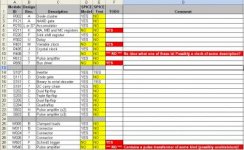rorypoole
Veteran Member
I am working on the best way to get a load of pcb's cut and etched to make the flip chips to build my PDP8 straight 8.
I will be only having made flip chip cards made that are used in the PDP8 straight 8, I will have some just cut to size and un-etched, single and double paddle.
I have found a source of cheap dec type handles but only in white for the flip chip copys.
as it costs a lot to get setup a pcb fabrication and the more cards i get made the cheaper each one is, I thought others may want to refill there spears box? or build a PDP8 straight 8? I would like to know if any one is interested in a few cards? I think they will cost about $20 each (not counting postage from England) depending if you want an
un-etched board,
etched board for a certain type of flip chip,
or the same but with modern equivalents components soldered in?
all would come with white dec type handles
the un-etched pcb's could be etched by yourself for any design, all the info you would need is here http://so-much-stuff.com/pdp8/flipchip/flipchip.php
if you are interested reply to this thread with the type and amount you would be interested in, the more the better!
Memory Utilization Module List for pdp8
http://homepage.cs.uiowa.edu/~jones/pdp8/hard8/memmap.html
Processor Utilization Module List for pdp8
http://homepage.cs.uiowa.edu/~jones/pdp8/hard8/cpumap.html
I will be only having made flip chip cards made that are used in the PDP8 straight 8, I will have some just cut to size and un-etched, single and double paddle.
I have found a source of cheap dec type handles but only in white for the flip chip copys.
as it costs a lot to get setup a pcb fabrication and the more cards i get made the cheaper each one is, I thought others may want to refill there spears box? or build a PDP8 straight 8? I would like to know if any one is interested in a few cards? I think they will cost about $20 each (not counting postage from England) depending if you want an
un-etched board,
etched board for a certain type of flip chip,
or the same but with modern equivalents components soldered in?
all would come with white dec type handles
the un-etched pcb's could be etched by yourself for any design, all the info you would need is here http://so-much-stuff.com/pdp8/flipchip/flipchip.php
if you are interested reply to this thread with the type and amount you would be interested in, the more the better!
Memory Utilization Module List for pdp8
http://homepage.cs.uiowa.edu/~jones/pdp8/hard8/memmap.html
Processor Utilization Module List for pdp8
http://homepage.cs.uiowa.edu/~jones/pdp8/hard8/cpumap.html
Last edited:

